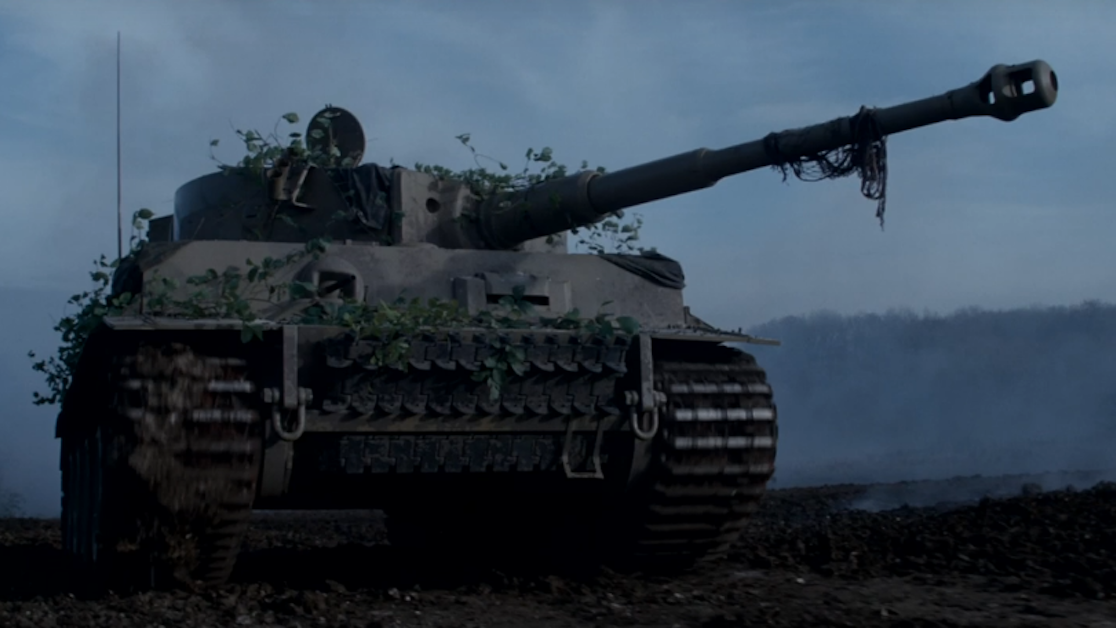The Tiger used in ‘Fury’ was captured after being disabled by the most improbable shots

SUMMARY
The Tiger tank had brutally efficient front armor. (Credit: Sony Pictures Releasing)
Out of nowhere, a shot cuts through the last Sherman tank in the column, blowing its turret off. The three remaining Shermans reverse from the road as another shot whizzes into the dirt, narrowly missing them. Backed into a wood line, the Shermans spot their ambusher - a German Tiger I tank. With no way out, the Shermans return fire and charge the Tiger. The shots from the Shermans bounce off of the Tiger's 100mm frontal armor with no effect.
Undeterred, the Tiger fires an 88mm shell straight through the front of a second Sherman. Continuing their charge toward the Tiger, a third Sherman is hit, its turret blown off of its hull. The last surviving Sherman finally gets around the Tiger and traverses its gun to aim at the weaker armor at the rear of the tank. Only after taking two shots through its vulnerable engine compartment does the deadly Tiger grind to a halt. With their tank ablaze, the surviving German crew members abandon the Tiger and are cut down by Sherman's hull-mounted .30-cal machine gun.
This scene from Sony Pictures' "Fury" has been viewed by millions of people online. Produced with the help of The Tank Museum in Bovington, UK, the scene features the only operating Tiger I tank in the world today.
Officially called the Panzerkampfwagen VI, Tiger I, Sd.Kfz. 181, the Tiger tank was heavily armored and equipped with the deadly 88mm gun. Paired with a well-disciplined crew, the Tiger was a menace to the allied armies during WWII. However, it was prone to track failures and mechanical breakdowns. The Tiger's operational range was also restricted by its high fuel consumption.
Built in February 1943, Tiger 131 was issued to the German 504th Heavy Tank Battalion and was shipped to Tunisia in March 1943 to reinforce the German defense of North Africa. As the allies prepared a major push toward Tunis, German forces launched a spoiling attack in April. On April 24, the British 2nd Battalion Sherwood Foresters, a line infantry regiment, took a location known as Point 174. The Germans immediately counter attacked with armor, including Tiger 131.
During the counter attack, British tanks of the 142nd Regiment Royal Armoured Corps and 48th Royal Tank Regiment arrived to reinforce the Foresters. German and British tank shells streaked past each other as the two sides vied for control. During the exchange, Tiger 131 was hit by three 6-pounder solid shot shells from British Churchill tanks.
The first shot hit the Tiger's barrel and ricocheted into its turret ring. The shell jammed the turret's traverse, destroyed the radio, and wounded the driver and radio operator. The second shell disabled the gun's elevation device when it hit the turret lifting lug. The third shot hit the loader's hatch and deflected shrapnel fragments into the turret. Unable to aim their main gun and continue the fight, the crew of Tiger 131 abandoned their tank.
After repelling the German counter attack, British forces discovered Tiger 131 on the battlefield and were surprised to find it intact and drivable—the first Tiger to be captured in such a state. Using parts from destroyed Tigers, British engineers repaired Tiger 131 to be inspected and evaluated. The tank was displayed in Tunis where it was shown to Prime Minister Winston Churchill and King George VI. In October 1943, Tiger 131 was sent to England and displayed around the country as a trophy to boost morale and fundraise before it was turned over to the School of Tank Technology. There, it was thoroughly inspected and assessed in order to aid future British tank design and evaluate its weaknesses to be exploited by allied troops on the front.
On September 25, 1951, Tiger 131 was transferred from the British Ministry of Supply to The Tank Museum in Bovington, UK, where it was put on display. In 1990, the tank was given a complete restoration by museum staff and the Army Base Repair Organisation, an executive agency of the UK's Ministry of Defence. In 2003, Tiger 131 returned to the museum in a fully functional state, making it the only working Tiger tank in the world. After further work and a repainting in period colors, the restoration was completed in 2012.
Because of its rarity, Tiger 131 has been the subject of many books, toys, and models. As previously stated, the tank gained further fame after it was used in the 2014 film "Fury." It has also been featured in the popular online tank game "World of Tanks." The Tank Museum keeps Tiger 131 well-maintained, taking it out for a "Tiger Day" exhibition at least once a year for the public to see it in motion.
The Tiger tank inspired confidence in its crew and fear in its enemies. Today, Tiger 131 serves not as a weapon of war, but as a well-preserved piece of history for people to see and learn from. The stewards of this history at The Tank Museum take great pride in their work and hope to continue to share it with the world for many decades to come.
SHARE
